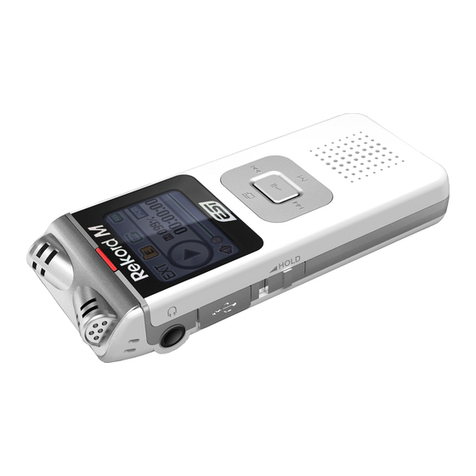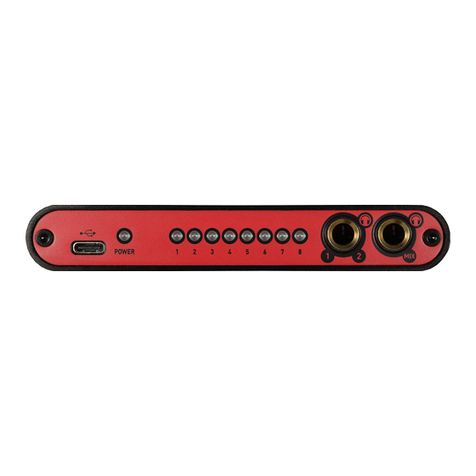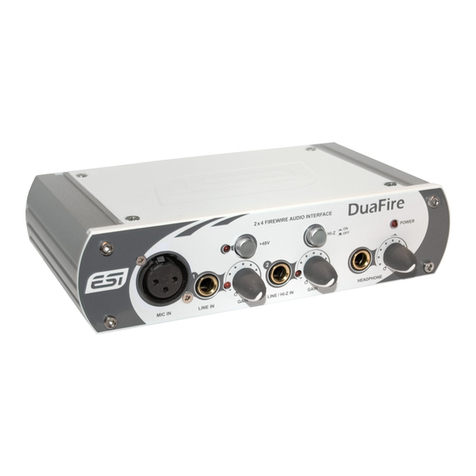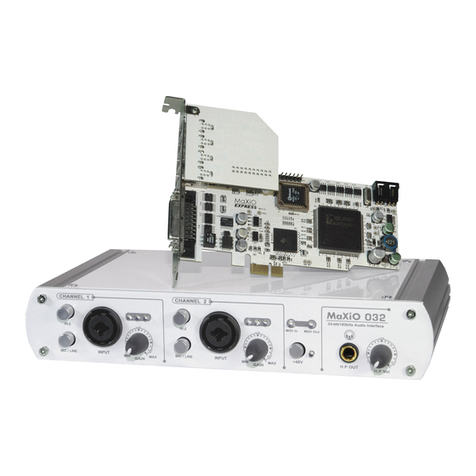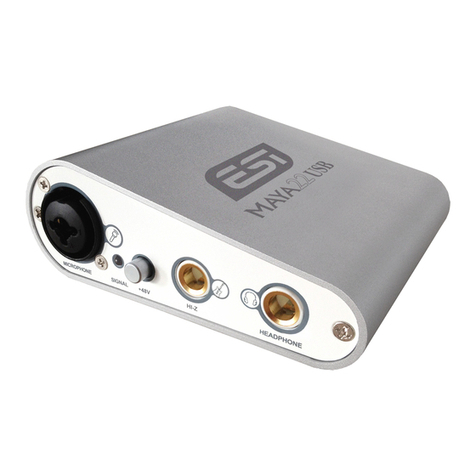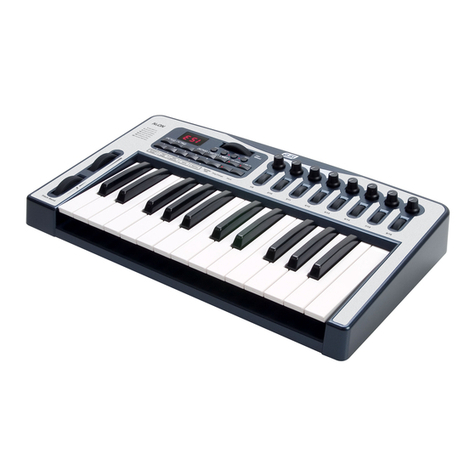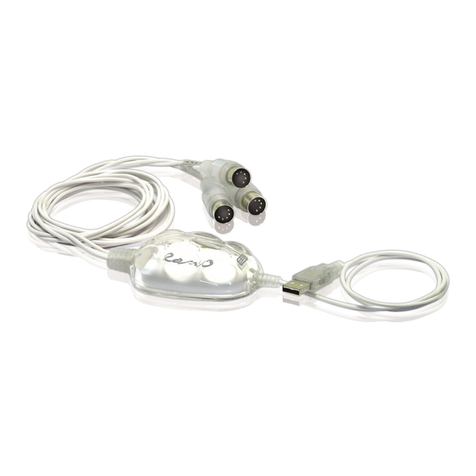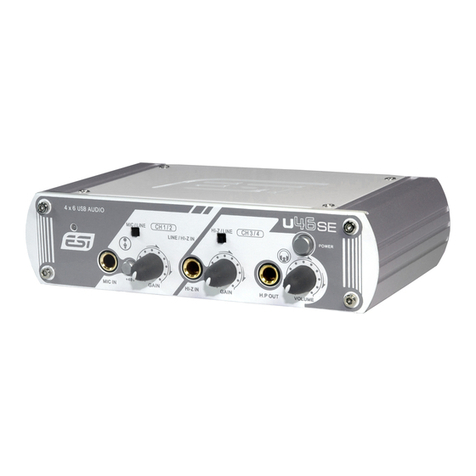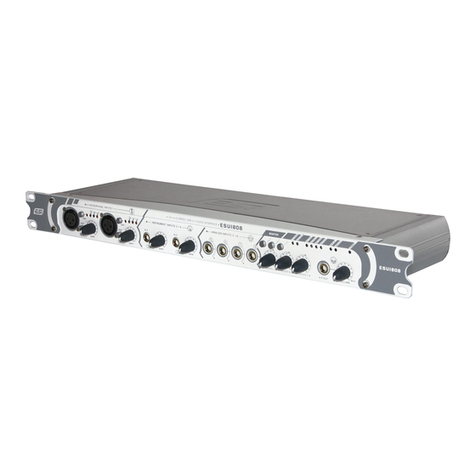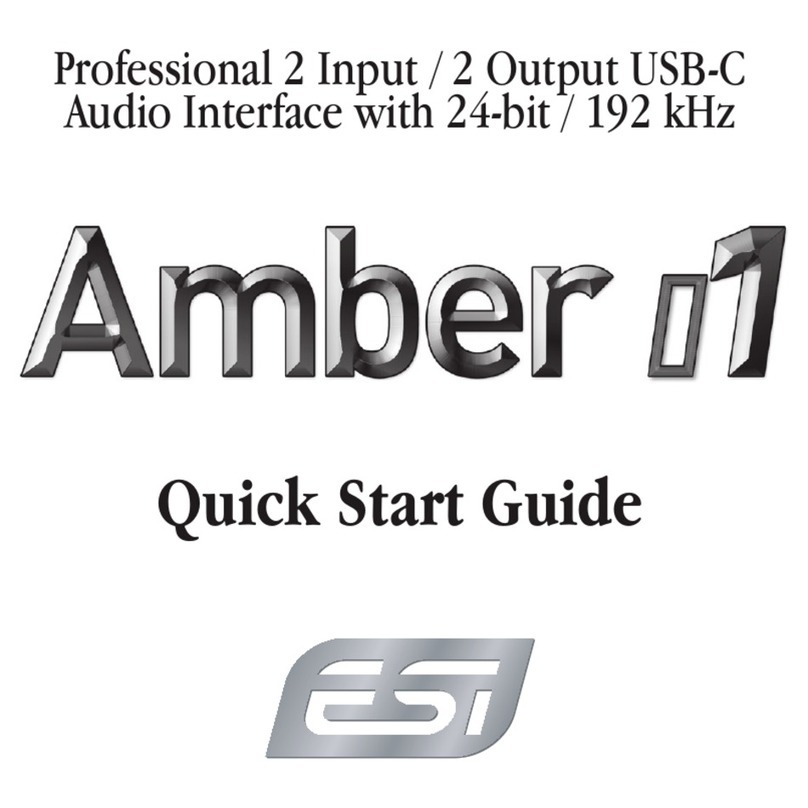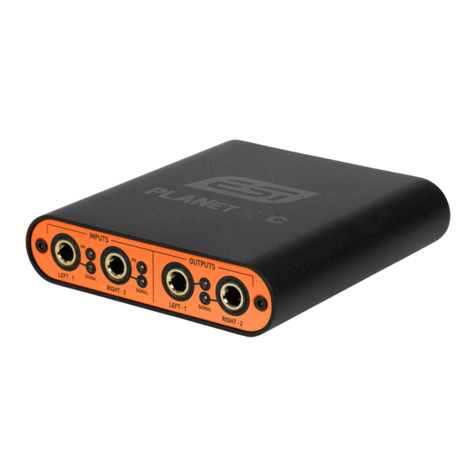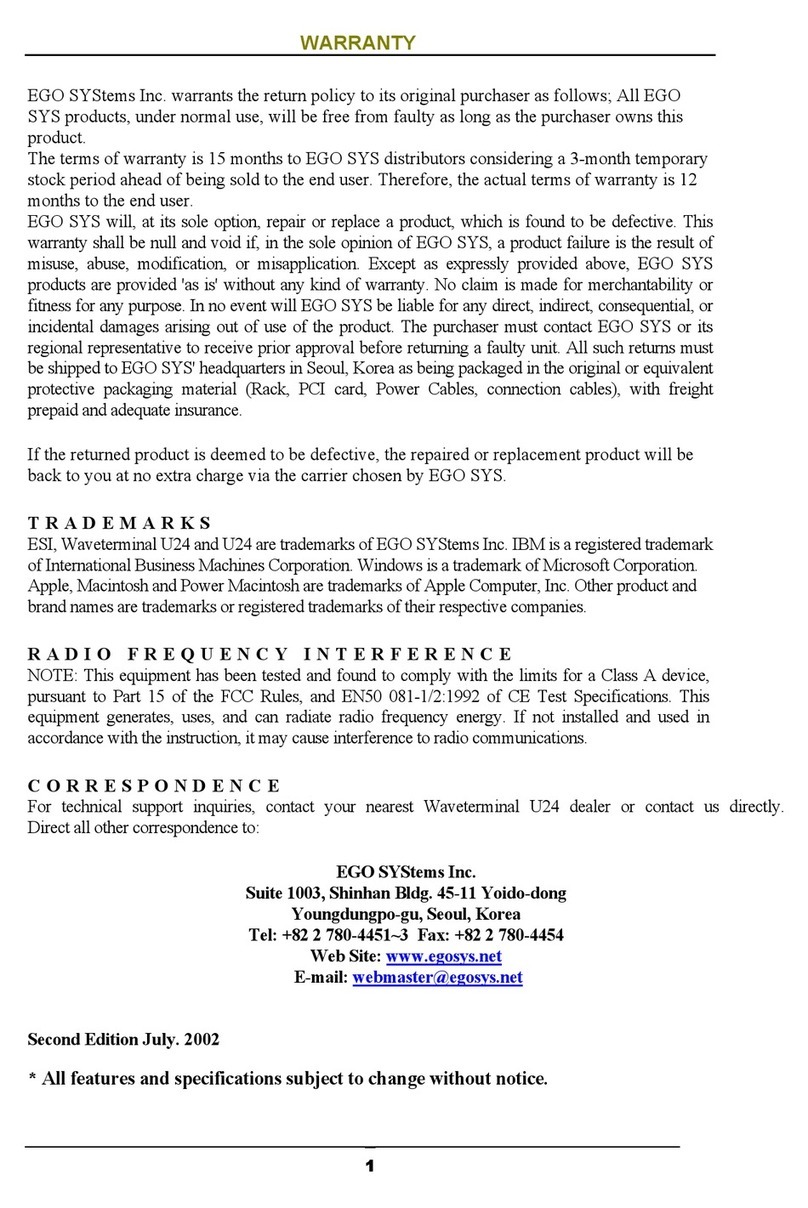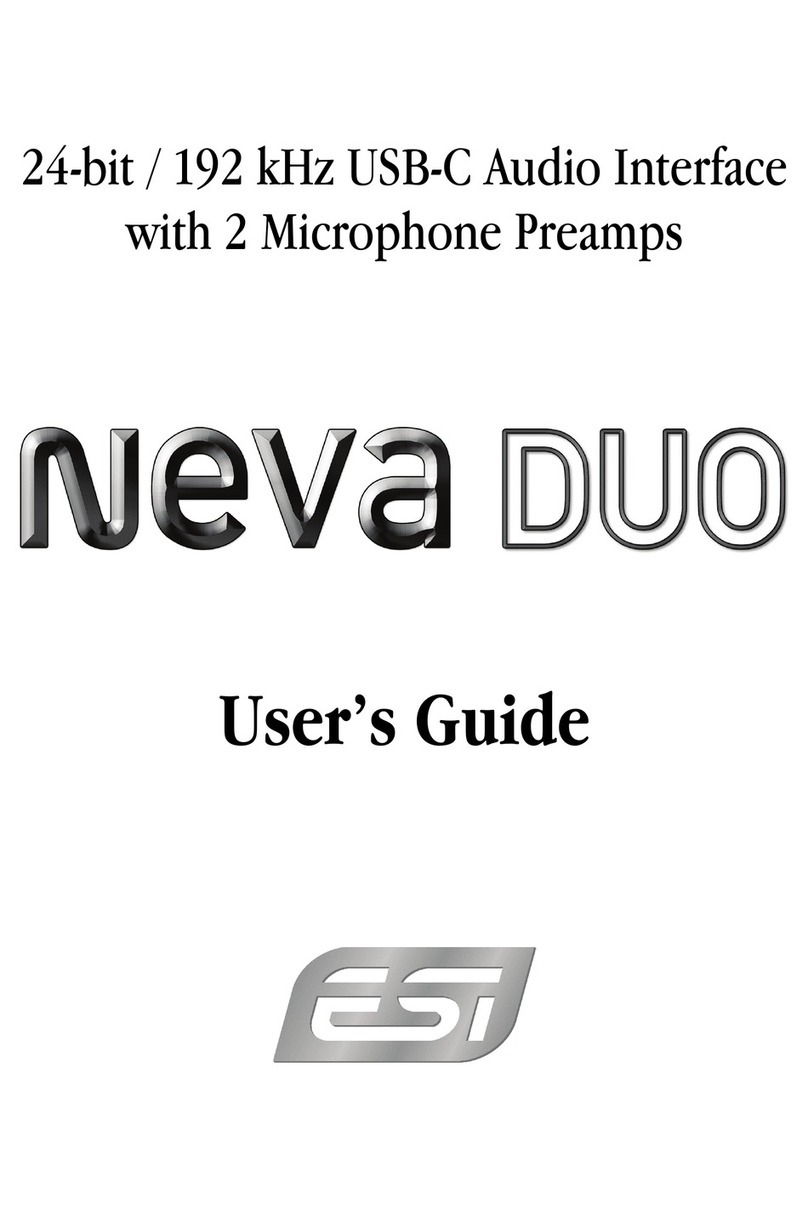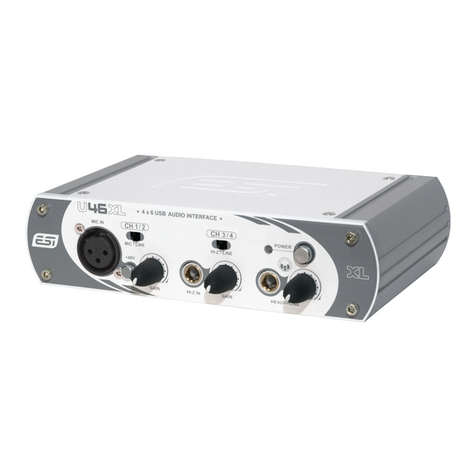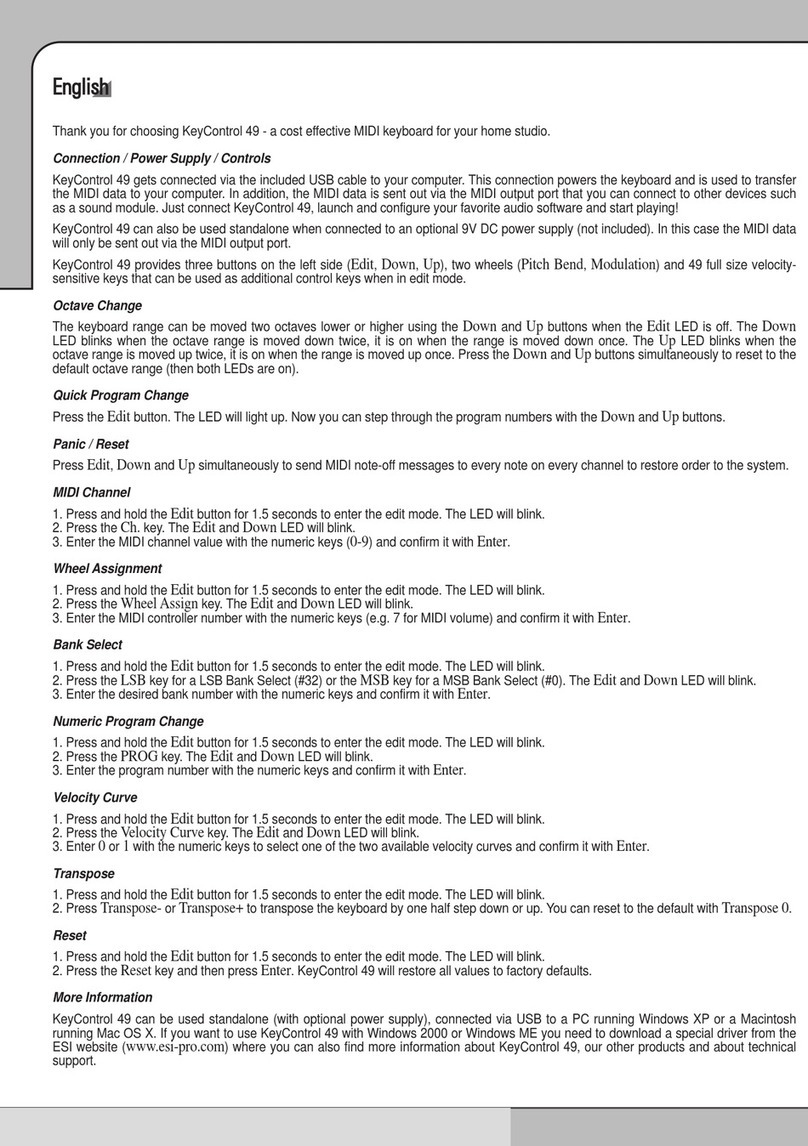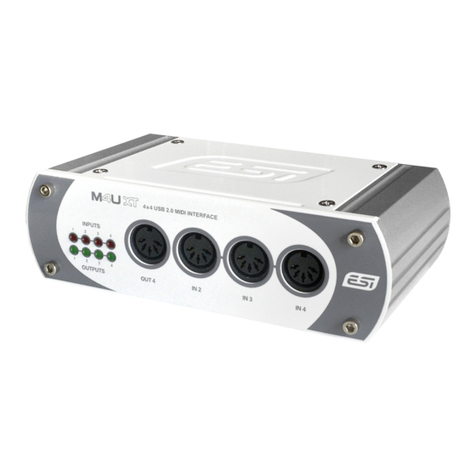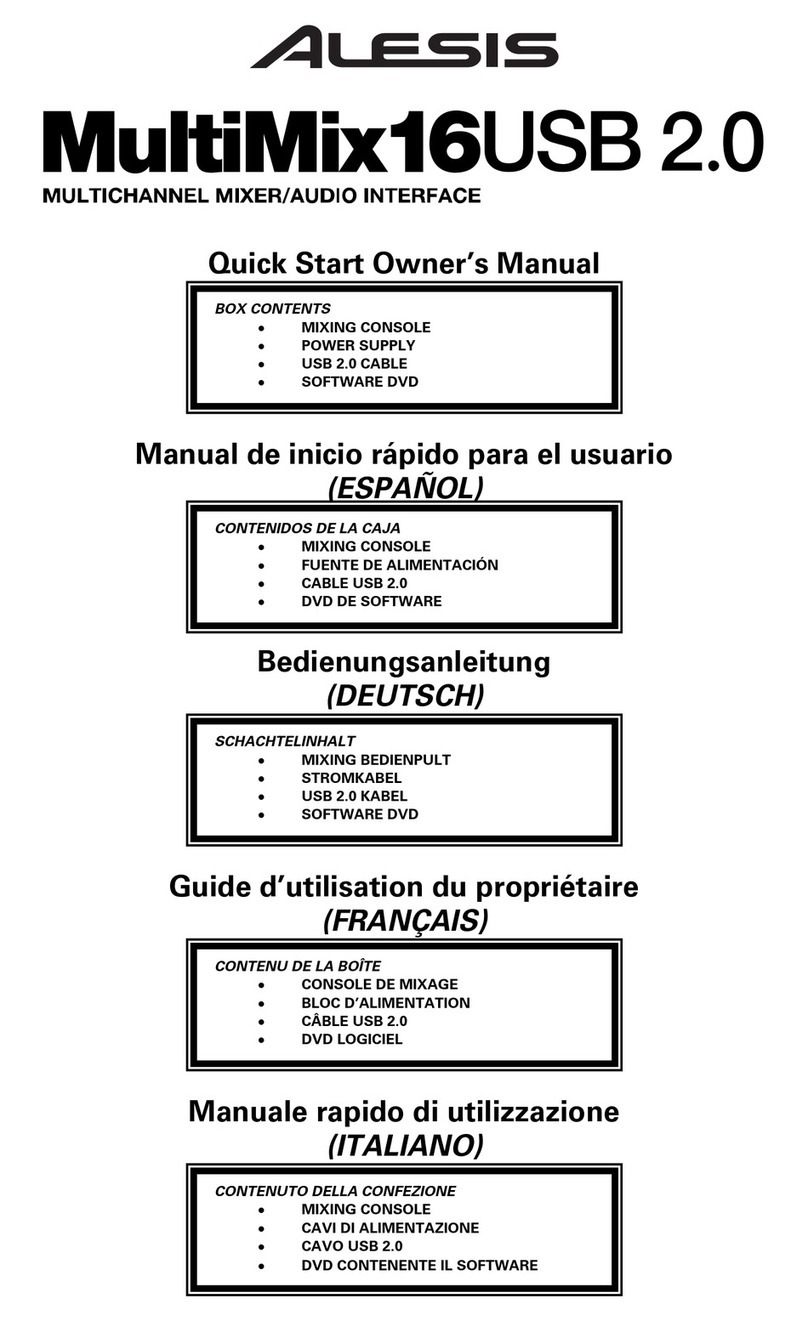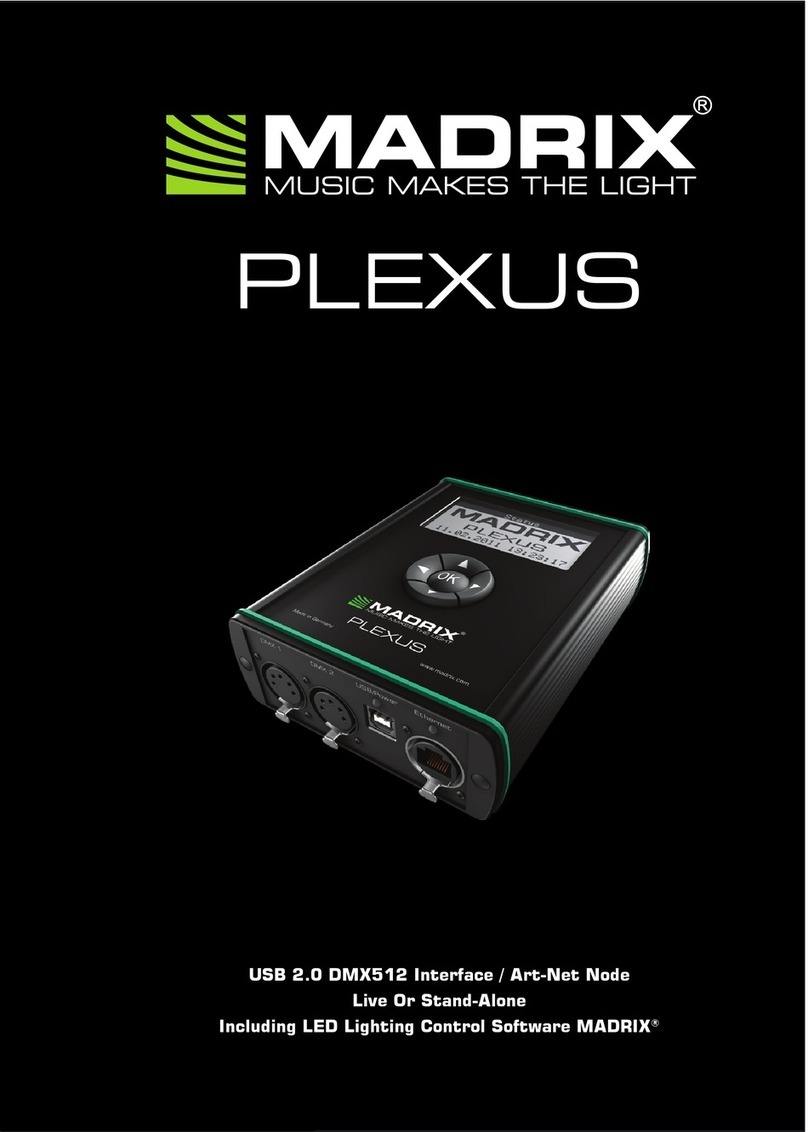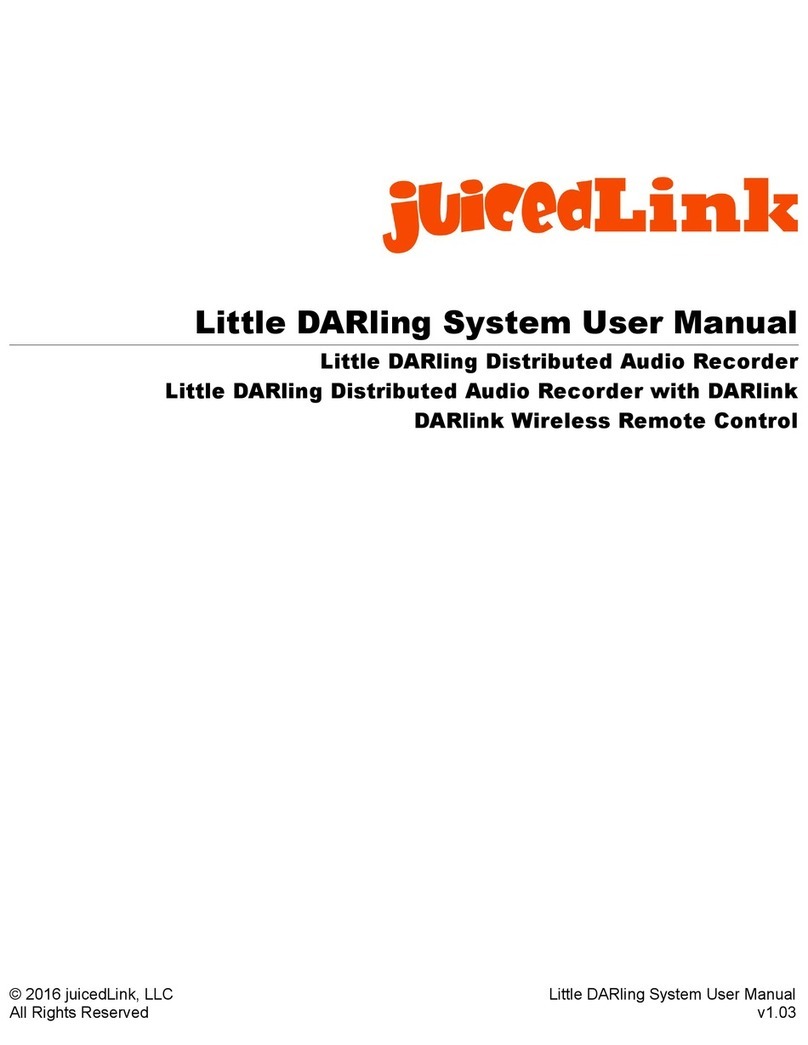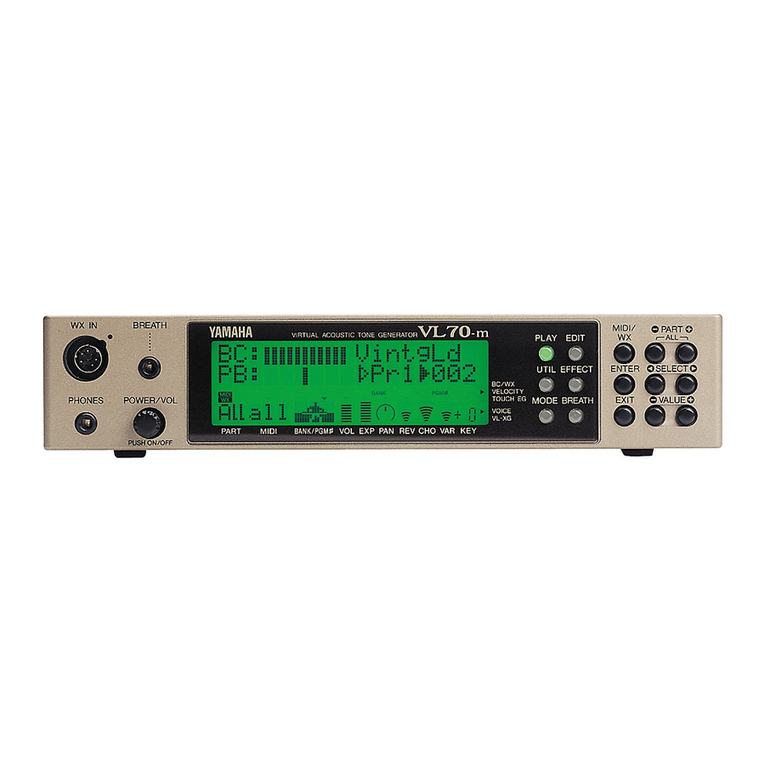ESI ESI2000 User manual

Contents i
IMPORTANT SAFETY INSTRUCTIONS
Use in countries other than the U.S.A. may require the use of a different
line cord or attachment plug, or both. To reduce the risk of fire or
electric shock, refer servicing to qualified service personnel. To reduce
risk of fire or electric shock do not expose this product to rain or mois-
ture.
GROUNDING INSTRUCTIONS
This product must be grounded. If it should malfunction or break down,
grounding provides a path of least resistance for electric current, reduc-
ing the risk of electric shock. This product is equipped with a cord
having an equipment-grounding conductor and a grounding plug. The
plug must be plugged into an appropriate outlet properly installed and
grounded in accordance with all local codes and ordinances.
DANGER
Improper connection of equipment grounding conductor can result in
the risk of electric shock. Check with a qualified electrician or service
personnel if you are in doubt as to whether the product is properly
grounded. Do not modify the plug provided with this product. If it will
not fit the outlet, have a proper outlet installed by a qualified technician.
CAUTION
If the 6200, ESI is rack mounted, a standard 19 inch open frame rack
must be used.
USER-MAINTENANCE INSTRUCTIONS
1. The ESI should be kept clean and dust free. Periodically wipe the
unit with a clean, lint free cloth. Do not use solvents or cleaners.
2. There are no user lubrication or adjustment requirements.
3. Refer all other servicing to qualified service personnel.
INSTRUCTIONS PERTAINING TO A RISK OF FIRE, ELECTRIC
SHOCK, OR INJURY TO PERSONS
WARNING; When using electric products, basic precautions should
always be followed, including the following:
1. Read all instructions before using the ESI.
2. To reduce the risk of injury, close supervision is necessary when the
ESI is used near children.
3. Do not use the ESI near water — for example near a bathtub,
washbowl, kitchen sink, in a wet basement, on a wet bar, or near or
in a swimming pool.
4. Situate the ESI so that its location or position does not interfere with
its proper ventilation.
5. The ESI should be located away from heat sources such as radiators,
heat registers, fireplaces, stoves, or ovens.
WARNING:
READ THIS
FIRST
This symbol is intended to alert the user to
the presence of important operating and
maintenance (servicing) instructions in the
literature accompanying the appliance.
This symbol is intended to alert the user to
the presence of un-insulated dangerous
voltage within the product's enclosure that
may be of sufficient magnitude to constitute
a risk of electric shock to persons.

ii ESI Operation Manual
6. The ESI should only be connected to a power supply of the type
described in the operating instructions and as marked on the
product.
7. Care should be taken so that objects do not fall and liquids are not
spilled into the enclosure of the ESI through openings.
8. This ESI may be equipped with a polarized line plug (one blade
wider that the other). This is a safety feature. If you are unable to
insert this plug into the outlet, do not defeat the safety purpose of
the plug. Contact an electrician to replace your obsolete outlet.
9. The power supply cord of the ESI should be unplugged from the
outlet when left unused for a long period of time.
10. This product, in combination with an amplifier and headphones and
speakers, may be capable of producing sound levels that could cause
permanent hearing loss. Do not operate for a long period of time at a
high volume level or at a level that is uncomfortable. If you experi-
ence any hearing loss or ringing in the ears, consult an audiologist.
11. The product should be serviced by qualified service personnel when:
A. The power supply cord has been damaged; or
B. Objects have fallen, or liquid has been spilled into the product; or
C. The product has been exposed to rain; or
D. The product has been dropped or the enclosure damaged; or
E. The ESI does not operate normally or exhibits a marked change
in performance.
12. All servicing should be referred to qualified service personnel.
SAVE THESE INSTRUCTIONS
CAUTION: TO REDUCE THE RISK OF ELECTRIC SHOCK
DO NOT REMOVE COVER.
NO USER-SERVICEABLE PARTS INSIDE
REFER SERVICING TO QUALIFIED PERSONNEL
CAUTION
RISK OF ELECTRIC SHOCK
DO NOT OPEN

Contents iii
RADIO and TELEVISION INTERFERENCE
The equipment described in this manual generates and uses radio-
frequency energy. If it is not installed and used properly — that is, in
strict accordance with our instructions - it may cause interference with
radio and television reception.
This equipment has been tested and complies with the limits for a Class
A computing device in accordance with the specifications in Subpart J of
Part 15 of the FCC rules. These rules are designed to provide reasonable
protection against such interference in a residential installation. How-
ever, there is no guarantee that the interference will not occur in a
particular installation, especially if a “rabbit ear” TV antenna is used.
If the ESI does cause interference to radio or television reception, you
can try to correct the interference by using one or more of the following
measures:
• Turn the television or radio antenna until the interference stops.
• Move the ESI to one side or the other of the television or radio.
• Move the ESI farther away from the television or radio.
• Plug the ESI into an outlet on a different circuit than the television
or radio.
• Consider installing a rooftop antenna with a coaxial lead-in between
the antenna and television set.

iv ESI Operation Manual

Contents v
Contents
1 General Instructions
Introduction ......................................................................................... 3
The ESI ................................................................................................ 4
Connection Instructions ....................................................................... 6
Connection Diagram ............................................................................. 7
Connecting to an Unformatted Hard Disk ............................................ 9
Sampling Basics .................................................................................. 10
Definitions .......................................................................................... 11
Additional Definitions......................................................................... 15
2 Controls
Master Volume .................................................................................... 21
Data Entry Control ............................................................................. 21
Inc/Dec Buttons .................................................................................. 21
Ten Key Pad ........................................................................................ 21
Escape ................................................................................................ 21
Enter ................................................................................................... 21
Cursor/Page ........................................................................................ 22
Preset Selection ................................................................................... 22
Save Bank ........................................................................................... 23
Load Bank ........................................................................................... 23
Drive Select......................................................................................... 24
Audition ............................................................................................. 24
Trigger Mode ...................................................................................... 24
Multimode .......................................................................................... 25
Transpose............................................................................................ 25
3 Guided Tours
Tour 1: Basics...................................................................................... 29
Tour 2: Selecting Zones....................................................................... 33
Tour 3: Dynamic Processing................................................................ 35
Tour 4: Realtime Controls ................................................................... 42
Tour 5: Sampling ................................................................................ 45
Tour 6: Digital Processing ................................................................... 47
A Practice Sampling Session ......................................................... 48
Tour 7: Managing the Bank ................................................................. 54
Tour 8: On Your Own ......................................................................... 54

vi ESI Operation Manual
The Modules
4 Master/Global
1. Master Tune .................................................................................... 57
2. Rename Bank .................................................................................. 57
3. Erase Bank ...................................................................................... 58
4. Effects ............................................................................................. 58
5. Export............................................................................................. 59
6. Memory Available ........................................................................... 60
7. Disk Utilities ................................................................................... 60
0. SCSI Setup ......................................................................... 61
1. Mount Drives ..................................................................... 62
2. Rename Disk Bank ............................................................. 62
3. Erase Disk Bank ................................................................. 63
4. Lock Bank & Drive ............................................................ 63
5. Disk Status ......................................................................... 64
6. Format Disk ....................................................................... 65
7. Backup ............................................................................... 67
8. Special ............................................................................................ 70
1. Recalibrate ......................................................................... 71
2. Contrast ............................................................................. 71
3. Headroom/Boost ................................................................ 72
4. Main Output Format .......................................................... 73
5. Software Version ................................................................ 73
6. View Channels ................................................................... 74
7. Trigger Buttons ................................................................... 74
8. RAM Test............................................................................ 75
9. MIDI .............................................................................................. 76
1. MIDI Mix ........................................................................... 77
2. MIDI Globals ..................................................................... 78
Basic Channel ...................................................................... 78
MIDI Mode .......................................................................... 78
Continuous Controller Assignment....................................... 79
3. MIDI Load Bank ................................................................. 81
4. MIDI Volume Pedal ............................................................ 81
5. MIDI Volume/Pan............................................................... 82
6. Multimode Enable .............................................................. 82
0. Import Options............................................................................... 83
0. Akai Import........................................................................ 83
1. Emax II Import .................................................................. 89

Contents vii
5 Sample Management
0. Select Sample .................................................................................. 95
1. Load Sample ................................................................................... 95
2. Rename Sample .............................................................................. 96
3. Erase Sample .................................................................................. 97
4. Copy Sample .................................................................................. 98
5. Sample Setup .................................................................................. 99
6. Place Sample ................................................................................. 101
7. Arm Sampling ............................................................................... 102
8. Force Sampling ............................................................................. 102
9. MIDI Sample Dump...................................................................... 103
6 Preset Management
1. Load Preset ................................................................................... 107
2. Rename Preset .............................................................................. 108
3. Erase Preset................................................................................... 109
4. Copy Preset .................................................................................. 109
5. Create Preset ................................................................................. 110
6. Preset Size ..................................................................................... 111
7. Merge All Presets .......................................................................... 111
7 Digital Processing
Background ...................................................................................... 114
0. Select Sample ................................................................................ 121
1. Setup ............................................................................................ 121
2. Loop ............................................................................................ 122
3. Truncation .................................................................................... 125
4. Copy Region ................................................................................. 125
5. Cut Region.................................................................................... 127
6. Paste Region ................................................................................. 128
7. Digital Tools I ............................................................................... 131
0. Sample Calculator .............................................................. 131
1. Taper .................................................................................. 132
2. Gain Change ...................................................................... 133
3. Reverse Section .................................................................. 135
4. Stereo <-> Mono ................................................................ 135
5. Left <-> Right ..................................................................... 136
6. DC Filter ............................................................................ 136
7. Sample Integrity ................................................................. 137
8. Digital Tools II .............................................................................. 138
0. Sample Rate Convert .......................................................... 139
1. Digital Tuning .................................................................... 140
2. Compressor ........................................................................ 141
3. Parametric Equalizer .......................................................... 145
4. Time Compression ............................................................. 146

viii ESI Operation Manual
5. Pitch Change ...................................................................... 147
6. Transform Multiply ............................................................ 148
7. Doppler/Pan ....................................................................... 149
8. Sonic Enhancer .................................................................. 155
9. Undo ............................................................................................ 156
8 Preset Definition
0. Realtime Controls ......................................................................... 161
1. Load Zone..................................................................................... 166
2. Edit Assignment............................................................................ 169
3. Erase Zone .................................................................................... 172
4. Copy Zone .................................................................................... 173
5. Crossfade/Switch .......................................................................... 176
6. Velocity Switch/Preset Link ........................................................... 183
7. Pitch Bend Range .......................................................................... 183
8. Portamento/Attack ........................................................................ 184
9. Effects ........................................................................................... 185
9 Dynamic Processing
Background ...................................................................................... 189
0. Select Zone ................................................................................... 196
1. Setup ............................................................................................ 197
2. VCA .............................................................................................. 198
3. VCF .............................................................................................. 200
4. LFO .............................................................................................. 202
5. Auxiliary Envelope ....................................................................... 204
6. Velocity To .................................................................................... 205
7. Keyboard Mode ............................................................................ 207
8. Realtime Control Enable ............................................................... 208
9. Channel Assignment ..................................................................... 209
10 Appendix
Effects ............................................................................................ 215
Effects Parameters ............................................................................. 231
Using SCSI........................................................................................ 237
Disk Drive Compatibility .................................................................. 241
Keyboard Character Chart ................................................................ 242
ESI Menu Map .................................................................................. 243
MIDI Key Number Chart .................................................................. 244
MIDI Implementation Chart ............................................................. 245
Specifications .................................................................................... 246
Error Codes ...................................................................................... 247
Troubleshooting ................................................................................ 249
Warranty ........................................................................................... 253
Index ................................................................................................ 255

Intro/Basic Setup 1
1 General Instructions
Introduction ............................. 3
The ESI .................................... 4
Connection Instructions .......... 6
Connection Diagram ................ 7
Connecting to a Hard Disk ...... 9
Sampling Basics ..................... 10
Definitions ............................. 11
Additional Definitions ........... 15

2ESI Operation Manual

Intro/Basic Setup 3
Introduction Welcome to the ESI Digital Sampling System. Congratulations are
definitely in order! The many functions of ESI are detailed in this
manual by their module. Screen displays and step-by-step instructions
are described for all aspects of use and operation. Sidebars are used to
highlight important points or to give useful operational tips which might
not be readily apparent.
If you are totally unfamiliar with samplers and synthesizers in general,
you may need more information than this manual provides. We suggest
that you read some of the many books and magazines on the subject of
music synthesis. This will help you to get the most out of this extremely
powerful instrument.
We encourage you to take a moment now to read the E-mu Systems
warranty and to fill out and send in your warranty registration card. By
doing so, you are assured of receiving news of all updates and manual
revisions.

4ESI Operation Manual
ESI
ESI is the very latest in the long line of high quality and affordable E-mu
sampling products. ESI features 22.05 kHz and 44.1 kHz sampling rates
and 16-bit resolution for CD quality sound. Sampling can be performed
in either mono or true stereo. 64 channels of polyphony allow you to
stack sounds or create lush sequences without fear of channel “ripoff”.
The user-upgradable memory can be expanded to a maximum of 128
Mbytes using standard SIMM modules (Details and installation are
available at your E-mu dealer).
The ESI has full access to the huge library of sounds available from E-mu
and other sources. It is fully compatible with the legendary EIII and
EIIIX libraries, and can import Emax II and Akai S1000/S1100 banks. In
many cases, the ESI can import and convert programs faster than the
source unit!
The advanced features of the ESI make sampling easy. Samples can be
automatically truncated, normalized and placed on the keyboard as the
sample is taken. ESI also contains advanced tools such as Auto Correla-
tion, Loop Compression and Crossfade Looping which allow even the
most difficult sounds to be easily looped.
Samples can be digitally spliced and mixed with other samples, and
dynamically controlled from the keyboard using velocity and positional
crossfading and switching functions. Advanced digital processing
features such as Sample Rate Conversion, Compressor, Digital Paramet-
ric Equalizer and Digital Tuning allow you to shape raw samples more
quickly and with greater precision than computer based systems.
Additional digital processing functions include: Time Compression and
Expansion, which shorten or lengthen the time of samples without
changing the pitch; and Doppler/Pan, which allows you to move
samples forward and backwards in space as well as from side to side.
The Sonic Enhancer adds brilliance and cut to a sample, helping it to
stand out in a mix.
I
VOLUME
O
TRANSPOSE DIGITAL PROCESSINGSAMPLE MANAGEMENT
SAMPLE
PRESET
MASTER/GLOBAL
MULTIMODE PRESET MANAGEMENT DYNAMIC PROCESINGPRESET DEFINITION
DRIVE SELECT LOAD SAVE AUDITION TRIGGER MODE ESCAPE
MIDI
ENTER
DEC/NO
INC/YES ABC
JKL
TUV
DEF
MNO
WXY
QZ
GHI
PRS
TRIGGERS
123
456
789
0
2000

Intro/Basic Setup 5
The ESI contains 19 different filters types for each of its 64 channels.
The digital filters are very “analog sounding” and implement the follow-
ing filter types:
• 12, 24, or 36 dB/octave Lowpass filters with Resonance
• 2nd & 4th order Highpass filters with Resonance
• 2nd & 4th order Bandpass filters with Resonance
• Contrary Bandpass filter
• Three types of Swept EQ filters
• Three Phasers and one Flanger filter with Resonance
• Two morphing Vocal Formant filters
• Bottom Feeder
• Original ESi-32 24 dB/octave Lowpass filter
Modulation sources include three AHDSR envelope generators and a
multi-wave LFO per channel, as well as full MIDI modulation control
over virtually every parameter.
The ESI's unique Trigger Mode allows up to ten different samples to be
triggered from the front panel without connecting a keyboard, making it
an ideal tool for DJ's.
The ESI is 16 part multi-timbral which means you can create complex
sequences and sound effects.
Four polyphonic audio outputs with integral submix returns allow you
to process certain sounds separately and return them to the main
outputs without using up precious mixer channels. The Turbo option
card adds four additional submix outputs plus an Effects main output.
The ESI can access up to 999 samples per bank arranged in up to 256
presets. The integral 3.5" floppy disk drive provides a convenient means
of storing and loading banks. A built-in SCSI interface provides access to
external high density media such as hard disks, magneto-optical disks or
CD ROM.
A digital interface, available on the “Turbo” option, facilitates the transfer
of stereo digital audio between digital recorders, mixers, etc.
The Turbo option card also contains two stereo 24-bit digital effects
processors which add Reverb, Delay, Flanging and Distortion effects to
the ESI. Over 70 effects are implemented which can be applied on a per
MIDI channel basis or by keyboard “Zone”. Each preset can have its own
effect program when ESI is in Omni or Poly mode.
In developing ESI, we retained the logical and easy-to-use interface of
the industry-proven EIIIX and enhanced it with our state-of-the-art
G-chip and H-chip hardware. The G-chip allows smooth sample
transposition over a wide range while the H-chips retain the warm
character of analog filters.
ESI is an extremely powerful and reliable, seventh generation
instrument. We at E-mu Systems sincerely hope it will help you realize
and further your musical dreams.

6ESI Operation Manual
Connecting to a Mixer
Main Outputs: The ESI has provisions for a variety of output connec-
tion schemes. The most common hookup is probably using the main
stereo outputs. Output level is -10 dBm (approximately 1-2 volts RMS).
Output impedance is 1K ohm.
Submix Outputs/Mix In: In addition to the main stereo outputs, the
ESI has an additional pair of submix outputs which can be used when
individual processing on specific instruments is desired. Any combina-
tion of channels can be programmed to appear at the submix output
pair. Any keyboard zone (key range) can also be assigned to the submix
pair using the Output Channel function in the Dynamic Processing
module. MIDI channels can be assigned to the submix pair using the
Multimode Mix function in the Master/Global module.
✱
Tip:
Inserting a standard mono plug
halfway into either of the sub output jacks
allows you to sum into the main outputs
without a special cable. This is a handy
feature for those times when you run out of
mixer channels.
The Submix Outputs are stereo jacks with -10 dBm outputs on the tip of
the jack. Output impedance is 1K ohm. The ring of each submix jack is
a return input to the main outputs. By using a special cable shown
above, specific presets or MIDI channels can be externally processed and
then returned to the main mix.
Stereo Headphone Output: The headphone output is located on the left
side of the front panel and is capable of driving all types of stereo
headphones. The output level is controlled by the master volume
control.
Turbo Option Outputs: The optional Turbo card contains three addi-
tional output channel pairs: FX, Sub 2 and Sub 3. The stereo outputs are
accessed using a stereo plug adapter cable. The FX output is a duplicate
of the main outputs run through the effects processors. When MIDI
channels or Zones are programmed to “Main,” they appear at both the
FX and Main outputs. Submix outputs 2 and 3 incorporate “plug
sensing” which reroutes signals to the FX outputs if a plug is not in-
serted into the submix jack.
✱
Tip:
The submix outputs use a “plug
sensing” scheme which re-routes the signal
to the main outputs if a plug is not inserted.
Sub Output
Return
(To Main Output)
Tip Ring
To Effect From Effect
SEND/RETURN CABLES

Intro/Basic Setup 7
Connection Diagram
MIDI In
MIDI Controller
(MIDI Keyboard, Sequencer, etc.)
MIDI Out
Additional
MIDI
Devices
Mic or Line Inputs
MIDI In
Mains
Submix Out/Mix In
Power
Cord
Power Amp
Mixer
DAT Recorder, etc.
Digital Input Device
To Mixer
Main FX Outputs
Turbo Option Card
SCSI
SCSI Device
60 mS
Digital Effect Device
Digital I/O
To Digital Mixer, DAT, etc.
Other
Sampler
MIDI In
FX IN OUT
S/PDIF
SUB 2SUB 3
TIP=LEFT RING=RIGHT

8ESI Operation Manual
Sample Inputs
The two sample input jacks accept any low to high level input (micro-
phone to line level). Input impedance is 10K. The gain of the sample
input preamplifier is controlled from the setup screen in the Sample
Management module. When in the Sample Management module the
sample inputs can be monitored from the main outputs or the head-
phone jack.
MIDI Connection
ESI provides a MIDI IN, a MIDI OUT and a MIDI THRU port.
• The MIDI IN port connects to the MIDI OUT port of an external
MIDI controller which could be a keyboard, a sequencer, MIDI
drum kit or whatever. Note that the ESI can only respond to
information that your controller transmits. If your MIDI keyboard
does not have velocity and pressure sensitivity, the ESI will not
respond to velocity and pressure.
•MIDI OUT can be connected to another MIDI instrument or
computer. The MIDI OUT jack is used to transmit MIDI sample
dump information (transfers sample data).
•MIDI THRU simply re-transmits any information received at the
MIDI IN port. Use cords that have been designed specifically for
MIDI. While regular 5 pin DIN cords may work, they are not
shielded correctly for MIDI use and may cause ground loops
between equipment.
Footpedal and Footswitch Connection
Control pedals and footswitches can be connected if your MIDI
keyboard has inputs for them (most do). The MIDI keyboard translates
the controller movements into MIDI data which is received by ESI.
Controller data is sent over MIDI on a particular continuous controller
number assigned by your MIDI keyboard. ESI must be set to receive the
data using the same continuous controller number.
For more information, see MIDI Globals on page78.
110V / 220V Operation
The ESI may be used in either 110 volt or 220 volt environments at
either 50 Hz or 60 Hz. No change of voltage settings is required.
ESI automatically switches itself for 110 or 220 volt operation.
Digital I/O (Turbo option)
The optional Turbo card contains a digital interface which allows ESI to
transfer digital audio back and forth with other digital devices equipped
with S/PDIF digital I/O. Keeping the signal in the digital domain is
desirable to keep the signal to noise level as high as possible.
The digital input allows you to sample directly from a DAT recorder or
other digital device. The digital output reflects the data at the stereo
outputs of the ESI. See the Sample Management module and Main
Output Format (located under Special in the Master/Global menu) for
more information.
!Caution:
Only use cords designed
specifically for MIDI.
!Caution:
If you plan on having the ESI
Turbo Option Kit installed, please use only
low-profile SIMMs when adding RAM to
your ESI-4000.

Intro/Basic Setup 9
SCSI
The SCSI connector is a high-speed parallel interface which is used to
connect the ESI with internal or external mass storage devices such as
hard disks or magneto-optical discs. The SCSI port can be used to link
the ESI with an external computer for extremely fast file transfers. The
ESI also supports SMDI (SCSI Musical Data Interchange protocol) which
allows transfer of samples over SCSI.
For more information on SCSI installation, see, “Using SCSI” in the
Appendix of this manual. Also refer to the manual that accompanies
your external SCSI device.
Following are step-by-step instructions on how to connect the ESI to a
SCSI hard disk or other SCSI storage device.
Connecting the ESI to an External, Unformatted Hard Disk
Important: Make sure that all power to the ESI and the SCSI device
is turned OFF.
1. Position the SCSI device and the ESI in a stable location. Hard
disk drives are particularly susceptible to shock and vibration. Make
sure that you position your hard disk where it won't be bumped or
moved while in use.
2. Connect the SCSI device to your ESI using a quality SCSI cable.
Make sure that the connectors are firmly mated and that the wire
“keepers” are locked in place.
NOTE: There are two type of SCSI cables in common use: the
50-pin Centronics type and the 25-pin DB connector type. ESI uses
the Centronics type connector. If your external SCSI device uses the
DB connector you can use an adaptor cable to eliminate the
mismatch.
3. Set the SCSI ID of your external SCSI device to any number
other than 5 or 0. (5 is the default ID of the ESI, 0 is used by the
floppy drive). Consult the operation manual of your SCSI device for
this procedure.
4. Turn on the external SCSI device.
5. Apply power to the ESI.
6. Make sure the hard disk really is unformatted or contains
information you no longer want. Formatting a hard disk erases all
the data on it. Press the Load button. If the display reads, “No Valid
Drives” the drive isn't formatted. Continue on to step eight.
7. Format the hard disk. Press the Master/Global button, select Disk
Utilities (7), then Format (6). The display should read, “FORMAT
DISK”. Use the Data Entry Control to select your hard disk, then
press ENTER. The display asks, “Are You Sure?” Press the Inc/Yes
button to confirm. Formatting takes a few minutes. Time to take a
break.
!Caution:
NEVER connect or disconnect
the SCSI cable while power is applied to
either the ESI or the SCSI device. Doing so
may cause serious damage to both units!
✱
Tip:
Use the “Mount Drives” utility
(Master/Global, Disk Utilities, 1) whenever
an external SCSI device does not appear in
the list of available devices.
✱
Tip:
If you plan on expanding the
memory beyond 4 MB, a mass storage
device is almost a necessity. When dealing
with large banks of up to 128 MB, a floppy
disk drive simply doesn't cut it, even for
back-up. A hard disk is an absolute must!
Furthermore, the extremely useful “Undo”
function will not work without a hard drive
attached.

10 ESI Operation Manual
Sampling
Basics
Throughout this manual we will use the terms and concepts described
and defined below. Read through this section carefully, even if you don’t
retain it all. You can refer back periodically as you read through the
manual until you understand the basics and definitions.
The ESI is conceptually like a tape recorder. However, the recording
process is very different since the ESI digitally records into its computer
memory. Sounds for the ESI can be loaded via removable-media hard
disk, magneto-optical disk, CD-ROM using the SCSI interface; or
through the S/PDIF Digital interface; or even through the MIDI interface
using MIDI Sample Dump.
Computers can accept information only in the form of numbers, so the
ESI accepts audio signals coded into binary numbers. Samplers work by
examining (sampling) the incoming signal level at a very high rate
(44,100 times a second for compact discs), and sequentially recording
these different levels in memory. Once stored, these samples may be
played back (in the proper sequence, of course) to reconstruct the
original signal. For instance, if a two-second sound was being sampled at
44.1 kHz, it would require (2 X 44,100) or 88,200 samples to be
recorded. As you might imagine, shorter sounds require fewer samples.
A sound can be manipulated once it has been recorded. Playing back the
samples in reverse order from which they were stored plays the sound
backwards. Playing back the samples at a faster rate than the rate at
which they were stored raises the pitch. Playing back at a slower rate
lowers the pitch, much like a tape recorder’s variable speed control.
DIGITAL SAMPLING
The signal is repeatedly measured at a high rate and the measurements are
stored in digital memory. Upon playback, the measurements are converted back into voltages to
reconstruct the original waveform.
Percussive Voice
1 second
Each vertical line
represents a sample.
Each sample takes
a "snapshot" of the
instantaneous signal level.

Intro/Basic Setup 11
How the ESI Organizes Sounds
Sure, you’re anxious to start coaxing wonderful sounds from the instru-
ment—but the following is a necessary part of learning how to play the
ESI. It is important to understand how the ESI organizes sounds in order
to make best use of the instrument in the shortest possible time. Many
terms will be introduced now that show up later in the manual.
You can think of the ESI as resembling a collection of sound-organizing
modules, all contained within an the ESI bank. Pathways indicate how
information flows within the ESI. Let’s take a closer look at what makes
up this information, and how it is transferred from one section of the
instrument to another. We’ll start with individual samples, then work
our way through the system.
The Sample
Loading in any sound in mono or stereo creates a sample. A sample is
the raw material with which the ESI works. The total available sampling
time can be divided up any way you like—one long sample, lots of short
samples, a few medium samples, or any combination thereof.
The term sample commonly means two different things:
1. A digital recording of a complete sound, or
2. Each snapshot of the sound that makes up the complete sample.
Confusing? You bet! In this manual, we’ll assume sample means the
complete recorded sound unless indicated otherwise.
You can modify a raw sample in several ways:
•Transposition: A sample can be transposed up or down in pitch to
cover a particular range of the keyboard. By doing this, it is not
necessary to record a sample for every key.
•Digital Processing: In the ESI, Digital Processing might consist of
Looping a sample (allowing even short samples to play indefinitely),
Truncating (cutting off unneeded parts of a sample, thus saving
memory), or any of a number of digital processes that actually
change the raw sample data.
•Dynamic Processing: Just as synthesizers include signal processors
(filter, voltage-controlled amplifier, envelope generators, LFO, and
so on) to modify the sounds produced by the synth’s oscillators, the
ESI includes similar modules for modifying the sound of samples or
combinations of samples.
Definitions

12 ESI Operation Manual
The Preset
As mentioned above, a sample can be assigned to a single note on the
keyboard, or transposed polyphonically to cover a wider keyboard
range. A preset is one entire keyboard setup. The process of assigning,
and optionally transposing, samples to specific ranges of the keyboard is
called making a preset. Making a preset is a three-step process:
1. Create the preset and give it a number and name. The bank can
hold up to 256 Presets (000-255).
2. Place samples to different keyboard ranges. For example, with
five samples you could assign each sample to cover one octave of a
five octave keyboard. A sample can be assigned more than once
within a given preset, and assigned to more than one preset.
3. Choose from a number of available options that further define
the preset. Some examples are: assigning samples to partially or
fully overlap other samples, thus producing doubling effects, or
assigning dynamic control to individual samples in a preset. You can
modify zone parameters, and set up MIDI and dynamic processing
parameters.
The Zone
A particular range of the keyboard is called a zone. This zone can
include one or more samples and the zone’s boundaries need not be the
same as the boundaries of the samples contained in the zone. Zones free
you from having to think about where the actual samples are assigned.
You just select a range of keyboard (a zone) and go!
As an example, suppose you wanted to set the velocity response for the
entire keyboard. You would first select the zone range by playing the
lowest and highest keys when prompted by the ESI. Next you would set
the velocity response (in the Dynamic Processing module). Done.
Entire
Kybd
ZONE
Any
Range
= (Keyboard Range)
Sample 01
Fc
Secondary Samples
Primary Samples
Vel -> Level
Tuning
Pan
Sample 02 Sample 03 Sample 04
Sample 05 Sample 06 Sample 07 Sample 08
= Copied Zone
Table of contents
Other ESI Recording Equipment manuals
Popular Recording Equipment manuals by other brands
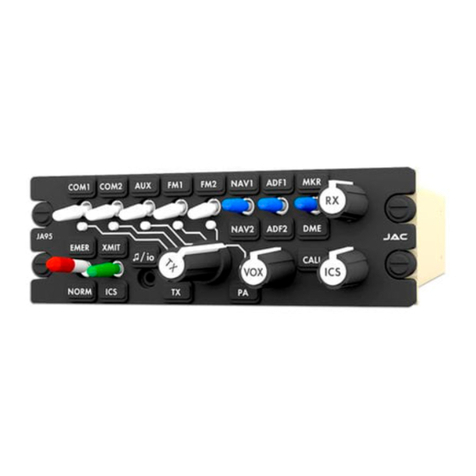
Jupiter Avionics
Jupiter Avionics JA95-N01 Installation and operating manual

MengQiMusic
MengQiMusic Voltage Memory manual
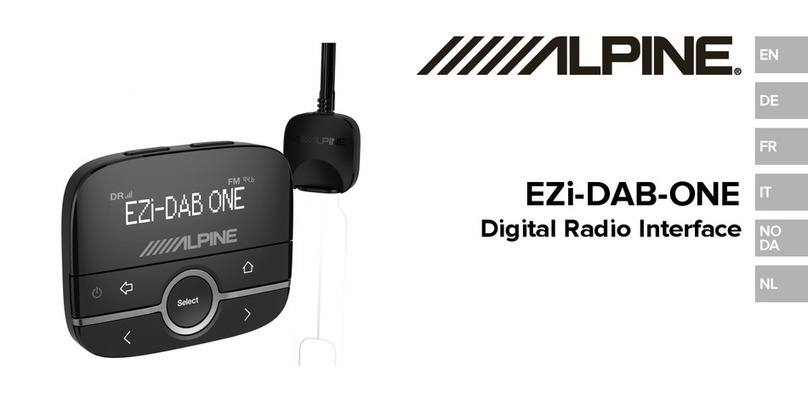
Alpine
Alpine EZi-DAB-ONE user manual
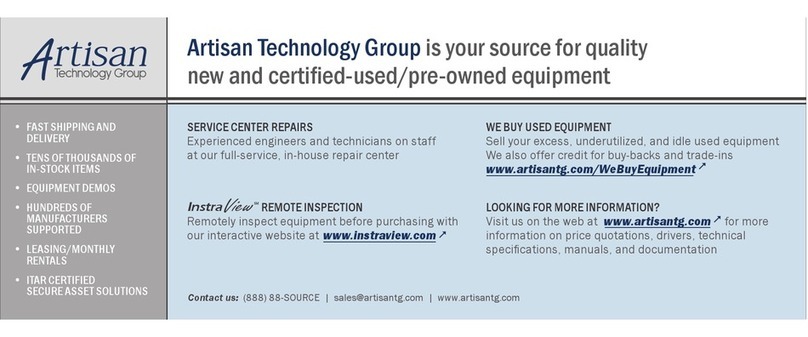
Agilent Technologies
Agilent Technologies 346A Installation note

KLING & FREITAG
KLING & FREITAG PLM 20K44 quick start guide
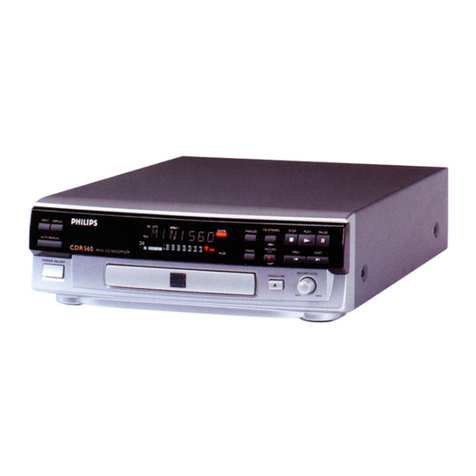
Philips
Philips CDR 538 Instructions for use
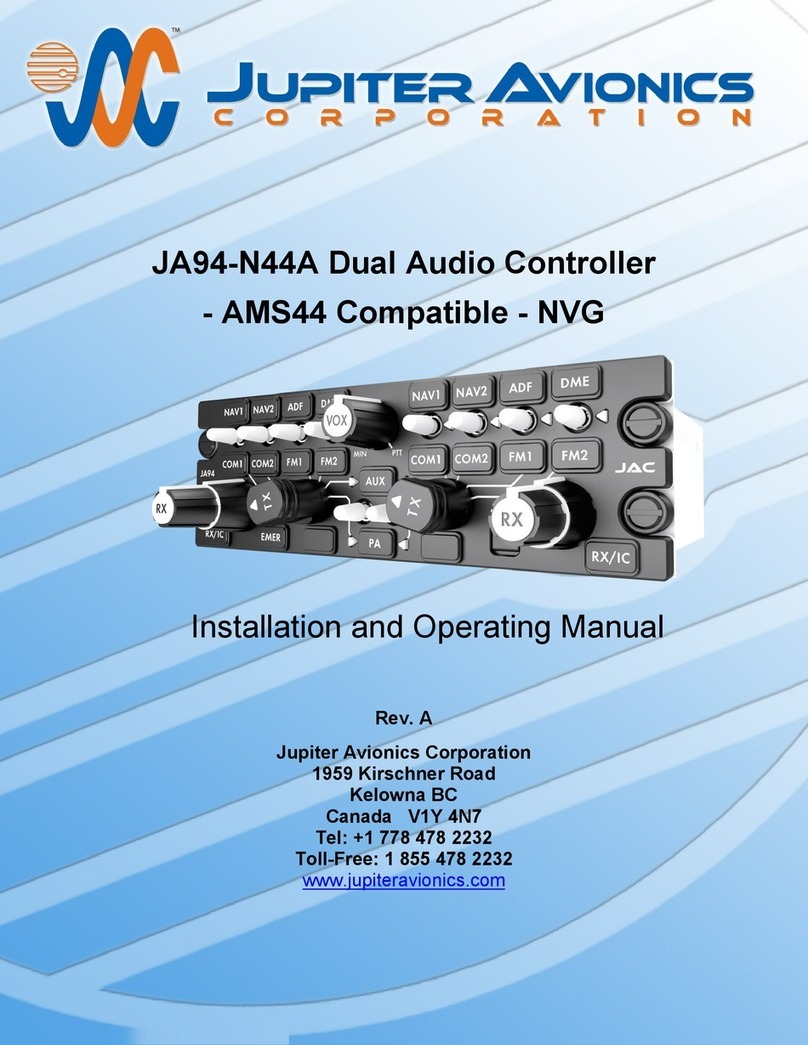
Jupiter Avionics
Jupiter Avionics JA94-N44A Installation and operating manual
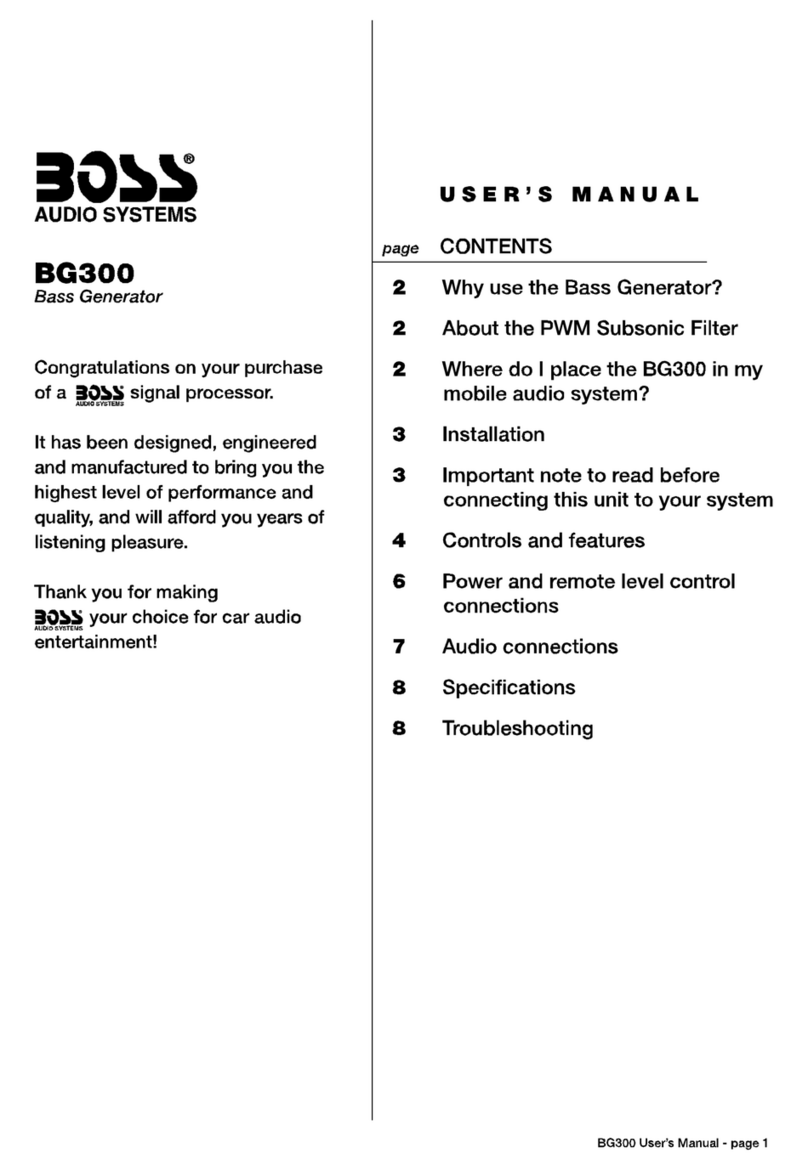
Boss Audio Systems
Boss Audio Systems Bass Generator BG300 user manual
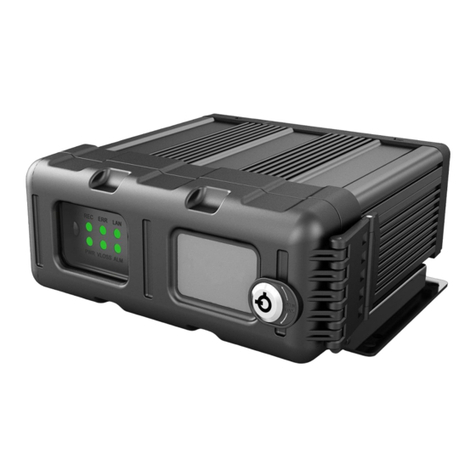
IOT-Smart Solutions
IOT-Smart Solutions MDAH1401 user manual
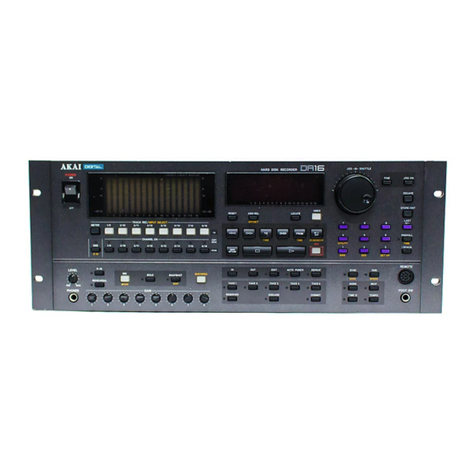
Akai
Akai DR16 pro Operator's manual
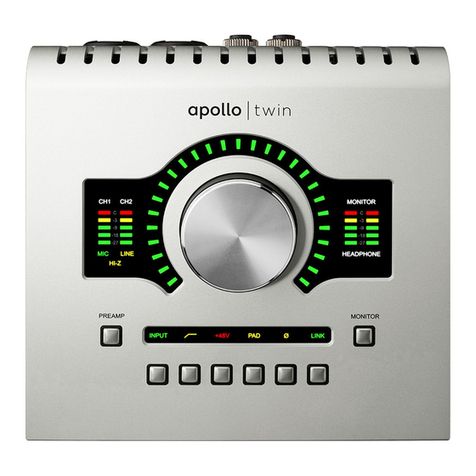
Universal Audio
Universal Audio Apollo Twin Customer support information
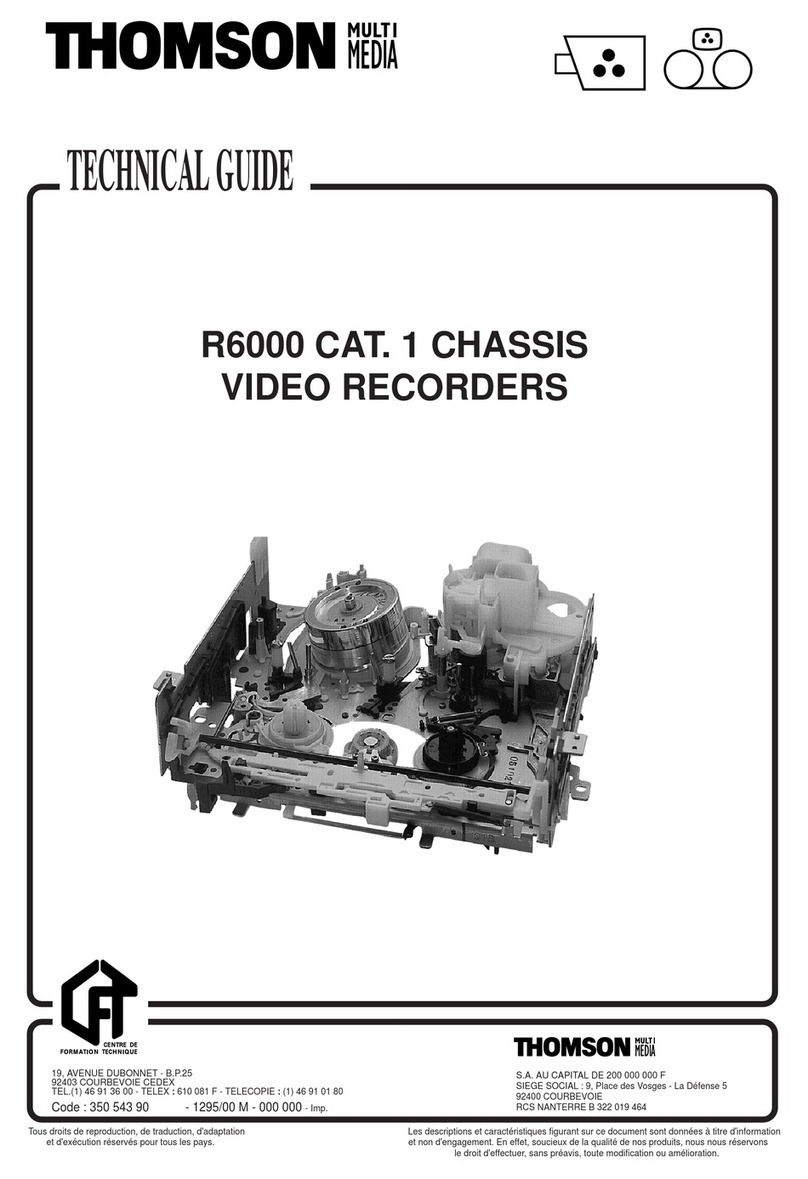
THOMSON
THOMSON VP2750 Technical guide
